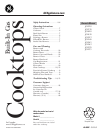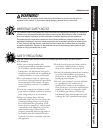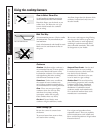
5
Safety Instructions
Operating Instructions
Care and Cleaning
Troubleshooting Tips Consumer Support
GEAppliances.com
Use proper pan size—avoid pans that are unstable or easily tipped. Select cookware having flat
bottoms large enough to cover burner grates. To avoid spillovers, make sure cookware is large
enough to contain the food properly. This will both save cleaning time and prevent hazardous
accumulations of food, since heavy spattering or spillovers left on cooktop can ignite. Use pans
with handles that can be easily grasped and remain cool.
WARNING!
SURFACE BURNERS
■ Always use the LITE position when
igniting the top burners and make sure
the burners have ignited.
■ Never leave the surface burners
unattended at high flame settings.
Boilovers cause smoking and greasy
spillovers that may catch on fire.
■ Use only dry pot holders—moist or damp
pot holders on hot surfaces may result in
burns from steam. Do not let pot holders
come near open flames when lifting
cookware. Do not use a towel or other
bulky cloth in place of a pot holder. Such
cloths can catch fire on a hot burner.
■ When using glass cookware, make sure
it is designed for cooktop cooking.
■ To minimize the possibility of burns,
ignition of flammable materials and
spillage, turn cookware handles toward
the side or back of the cooktop without
extending over adjacent burners.
■ Always turn the surface burner controls off
before removing cookware.
■ Carefully watch foods being fried at a high
flame setting.
■ Always heat fat slowly, and watch as it heats.
■ Do not leave any items on the cooktop.
The hot air from the vent may ignite
flammable items and will increase pressure
in closed containers, which may cause
them to burst.
■ If a combination of oils or fats will be used
in frying, stir together before heating or as
fats melt slowly.
■ Do not use a wok on the cooking surface
if the wok has a round metal ring that is
placed over the burner grate to support
the wok. This ring acts as a heat trap,
which may damage the burner grate and
burner head. Also, it may cause the burner
to work improperly. This may cause a
carbon monoxide level above that allowed
by current standards, resulting in a health
hazard.
■ Foods for frying should be as dry as
possible. Frost on frozen foods or moisture
on fresh foods can cause hot fat to bubble
up and over the sides of the pan.
■ Use the least possible amount of fat for
effective shallow or deep-fat frying. Filling
the pan too full of fat can cause spillovers
when food is added.
■ Use a deep fat thermometer whenever
possible to prevent overheating fat beyond
the smoking point.
■ Never try to move a pan of hot fat,
especially a deep-fat fryer. Wait until the
fat is cool.
■ When preparing flaming foods under the
hood, turn the fan on.
■ Do not leave plastic items on the cooktop—
they may melt if left too close to the vent.
■ Keep all plastics away from the surface
burners.
■ If you smell gas, turn off the gas to the
cooktop and call a qualified service
technician. Never use an open flame to
locate a leak.
■ To avoid the possibility of a burn, always be
certain that the controls for all burners are
at the off position and all grates are cool
before attempting to remove them.


















